When you're selecting canvas fabric, you'll encounter numerous variations that can greatly influence your project's outcome. Each type offers distinct characteristics regarding fiber composition, weight density, and weave construction. While you might be familiar with basic cotton canvas, there's a complex spectrum of options ranging from Belgian linen to synthetic blends. Understanding these distinctions will determine your project's durability, aesthetic appeal, and overall performance. Let's explore the essential factors you'll need to evaluate.
Key Takeaways
- Cotton canvas offers versatility and reliable performance, with cotton duck canvas known for strength through plain weave construction.
- Linen canvas provides superior strength and dimensional stability, featuring a finer surface texture ideal for professional applications.
- Synthetic canvas types like nylon and polyester deliver enhanced weather resistance, UV protection, and easier maintenance.
- Canvas weight classifications range from lightweight (4oz) to heavyweight (24oz), determining suitability for different applications.
- Plain weave offers basic patterns for artists, while duck weave provides tighter construction for superior water resistance.
Introduction to Canvas Fabric
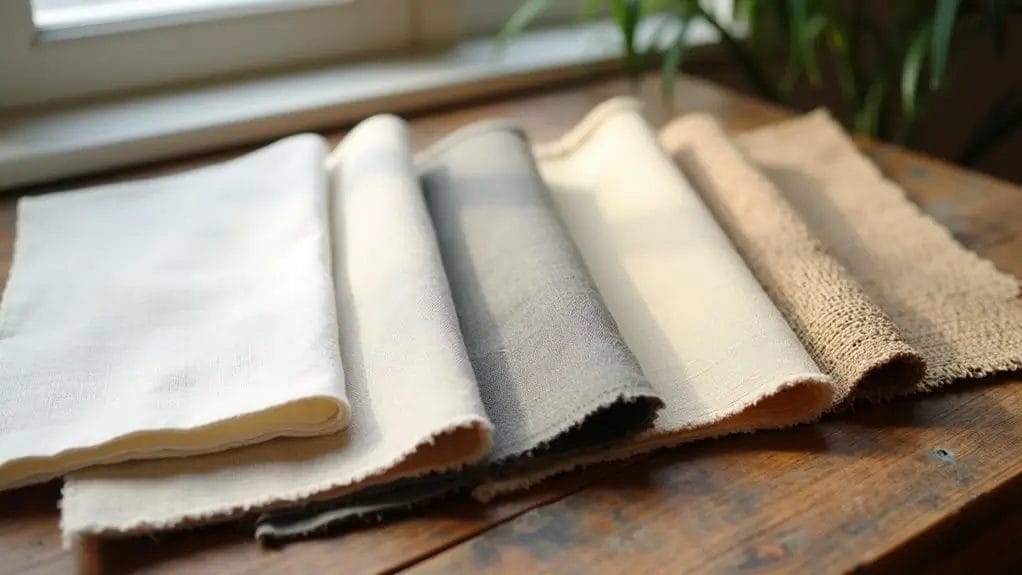
Canvas fabric is a durable, plain-woven textile composed of cotton, linen, or synthetic fibers that you'll encounter in industrial and artistic applications.
You'll recognize canvas by its characteristic heavy weight, tight weave pattern, and exceptional strength-to-weight ratio.
The fabric's versatility stems from its fundamental properties: high tear resistance, dimensional stability, and the ability to accept various treatments such as waterproofing or fire retardation.
What is Canvas?
Fabric manufacturers have long relied on canvas as one of the most durable and versatile woven textiles in production.
You'll find that canvas fabric is a plain-woven material characterized by its sturdy construction and tight weave pattern. The canvas material consists of either natural fiber (typically cotton or linen) or synthetic fibers (such as polyester or nylon), woven in a uniform plain weave structure.
What sets canvas apart is its distinctive diagonal pattern created when the weft threads pass over and under the warp threads.
This plain-woven fabric known for its durability can withstand heavy use, making it ideal for various commercial and artistic applications.
Characteristics of Canvas Fabric
Durability stands as just one of many distinguishing characteristics you'll find in quality canvas fabric.
When selecting canvas, you'll need to evaluate these key properties:
- Weave density determines the fabric's strength and texture, with plain weave being most common in cotton canvas and linen canvas varieties.
- Weight classification ranges from lightweight 4oz to heavyweight 24oz, impacting the fabric's dimensional stability.
- Surface texture varies from smooth to coarse, affecting both aesthetics and functional applications.
- Fiber composition influences performance - cotton canvas offers breathability, linen canvas provides crisp structure, and synthetic canvas delivers enhanced weather resistance.
You'll find these characteristics interact to determine the canvas's ultimate functionality and application suitability.
Different Types of Canvas
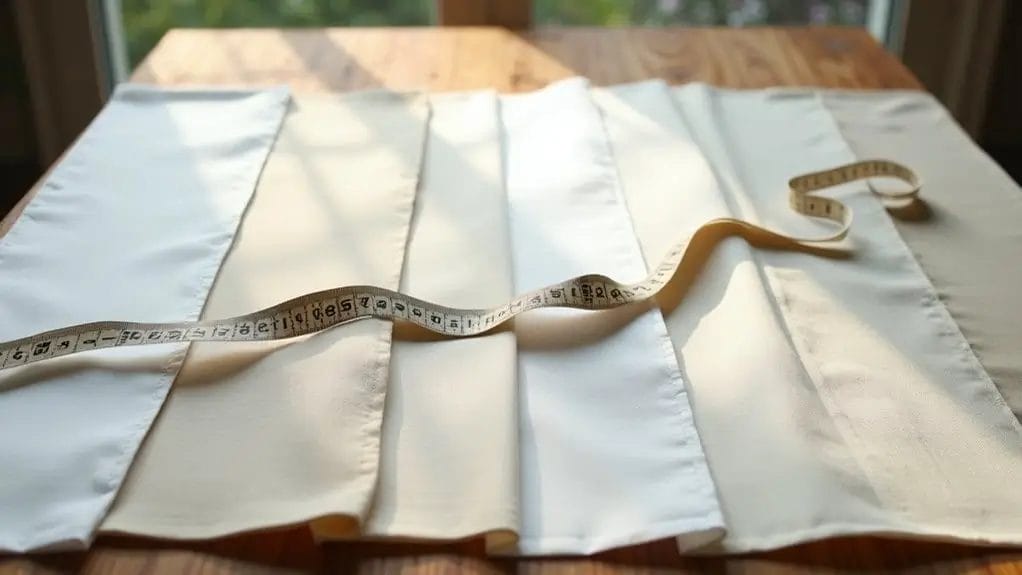
Selecting the right canvas fabric requires understanding the distinct properties of cotton, linen, synthetic, nylon, and acrylic variants.
You'll find cotton canvas offers excellent versatility and durability, while linen canvas provides superior strength and dimensional stability for professional applications.
If you're working in specialized environments, synthetic options like nylon and acrylic canvas deliver enhanced weather resistance and UV protection.
Cotton Canvas
Among the most versatile canvas materials, cotton canvas stands as the industry standard for both fine art and practical applications.
Cotton canvas is widely recognized for its exceptional texture and reliable performance across multiple uses.
- Cotton duck canvas provides superior strength through its plain weave construction, making it ideal for heavy-duty applications.
- When selecting canvas for painting, you'll find primed canvas offers an ideal painting surface that's ready for immediate use.
- The durable canvas structure allows for consistent tension and minimal sagging over time.
- You'll notice varying weights and textures, typically measured in ounces per square yard, affecting both handling and final results.
Linen Canvas
While cotton canvas meets many artists' needs, linen canvas represents the premium choice for professional painters and archival works.
The natural texture of linen fibers creates a tighter, more uniform weave compared to cotton, providing a smoother surface compared to standard canvas options.
Linen canvas comes with superior dimensional stability, resisting warping and sagging over time.
You'll find it's ideal for detailed work, especially with oil paints, as the fabric maintains tension better under varying environmental conditions.
The process of making linen canvas involves longer, stronger fibers that result in enhanced durability and longevity, though at a higher cost.
Synthetic Canvas
Modern synthetic canvas materials provide artists with innovative alternatives to traditional natural fibers. Synthetic materials like polyester canvas and nylon offer exceptional strength and versatility for your artistic endeavors.
- You'll find that polyester canvas features a tight weave structure, making it resistant to stretching and warping.
- Nylon-based canvases provide superior durability against environmental factors and UV exposure.
- These synthetic materials are easier to clean and maintain than natural fibers.
- You can expect consistent performance across different weather conditions, as synthetic canvas resists moisture and mildew.
Choose synthetic canvas when you need reliable, long-lasting support for your artwork, especially in challenging environments.
Nylon Canvas
Several nylon canvas varieties offer unique properties that make them ideal for specific artistic applications.
When choosing canvas made from synthetic fibers, you'll find that nylon provides exceptional strength and durability while maintaining a lighter weight than traditional cotton canvas. Its versatility makes it particularly suited for outdoor projects where weather resistance is essential.
You'll discover that nylon canvas excels in applications like tent manufacturing and outdoor furniture covers due to its water-repellent characteristics and resistance to UV damage.
The material's high tensile strength and ability to maintain structural integrity under stress make it a reliable choice for demanding environmental conditions.
Acrylic Canvas
Acrylic canvas represents a versatile synthetic option that combines polyester fibers with an acrylic coating to achieve superior weather resistance and color retention.
When choosing the right canvas for your acrylic paintings, you'll find this surface for paint offers exceptional durability.
- Pre-primed surface accepts acrylic paint readily, reducing preparation time
- Enhanced vibrancy retention keeps colors true for extended periods
- Resistant to environmental factors like moisture and UV damage
- Uniform texture provides consistent paint application across the surface
You'll notice these canvas types maintain their tautness better than natural alternatives, making them ideal for both indoor and outdoor display of your artwork.
Cotton Duck Canvas
Cotton duck canvas, a heavyweight plain-woven fabric, stands as the traditional foundation for fine art painting and has been the preferred choice among artists for centuries. When you're selecting duck canvas, you'll find it's manufactured in various weights, with numbers ranging from 1-12 (lower numbers indicate heavier fabric).
Unprimed canvas comes in both cotton and linen varieties, but cotton duck remains popular due to its durability and cost-effectiveness.
The canvas is woven tightly, creating a strong, dimensionally stable surface that's ideal for stretched canvas applications. You'll notice its distinctive diagonal weave pattern, which contributes to its strength and paint-holding capabilities.
Understanding Canvas Weave
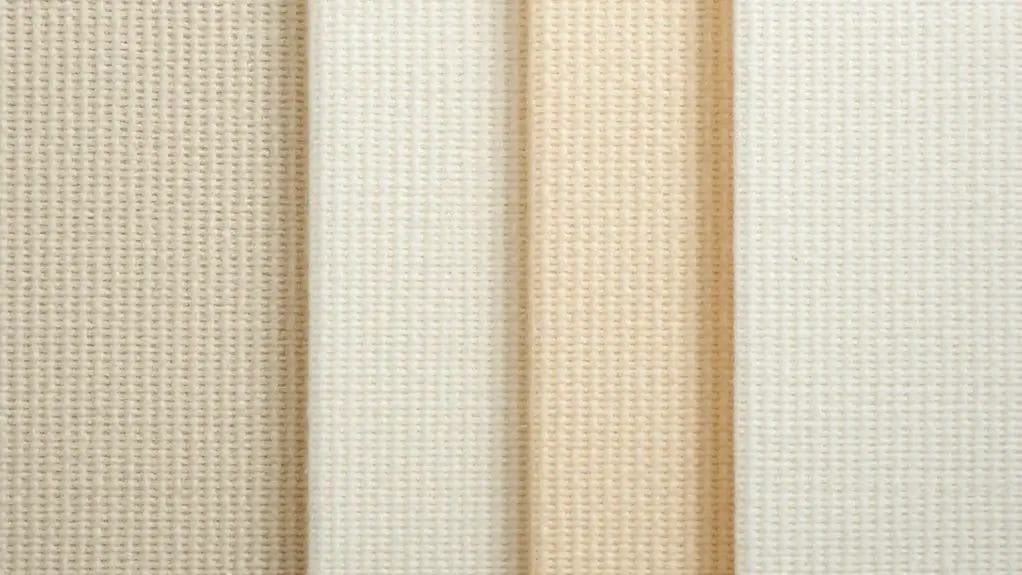
Canvas weave patterns determine the fabric's structural characteristics, with plain weave featuring a simple over-under pattern and duck weave utilizing a tighter, more complex interlacing technique.
You'll find that plain weave creates a balanced, uniform surface ideal for printing and painting, while duck weave produces a denser, more durable fabric suited for heavy-duty applications.
The weight of canvas fabric, measured in ounces per square yard, directly correlates to the weave pattern's complexity and thread count, affecting both texture and strength.
Plain Weave vs. Duck Weave
When selecting canvas material, understanding the fundamental difference between plain weave and duck weave will greatly impact your project's outcome.
Each type of canvas is made with distinct characteristics that affect your painting style and durability requirements.
- Plain weave offers a basic over-under pattern that's ideal for general canvas for artists, providing a balanced surface texture.
- Duck weave features a tighter, denser construction that's twice as strong as plain weave.
- Your canvas options depend on whether you need the strength of synthetic fibers or natural materials.
- Duck weave provides superior water resistance and durability, while plain weave excels in versatility.
Texture and Weight of Canvas Fabrics
Beyond the basic weave patterns, understanding fabric texture and weight specifications helps you select the ideal canvas for your specific application.
Canvas weight is measured in ounces per square yard, with options ranging from lightweight 4 oz to heavyweight 24 oz.
Cotton canvas offers a distinctive texture with natural fiber variations, making it suitable for painting and upholstery.
Linen canvas provides a finer, smoother surface texture with superior durability.
You'll find canvas in a variety of weights and textures designed for specific uses: lightweight canvas for fashion, medium weight for bags and accessories, and heavyweight options for industrial applications like tarps and covers.
Choosing the Right Canvas for Your Project
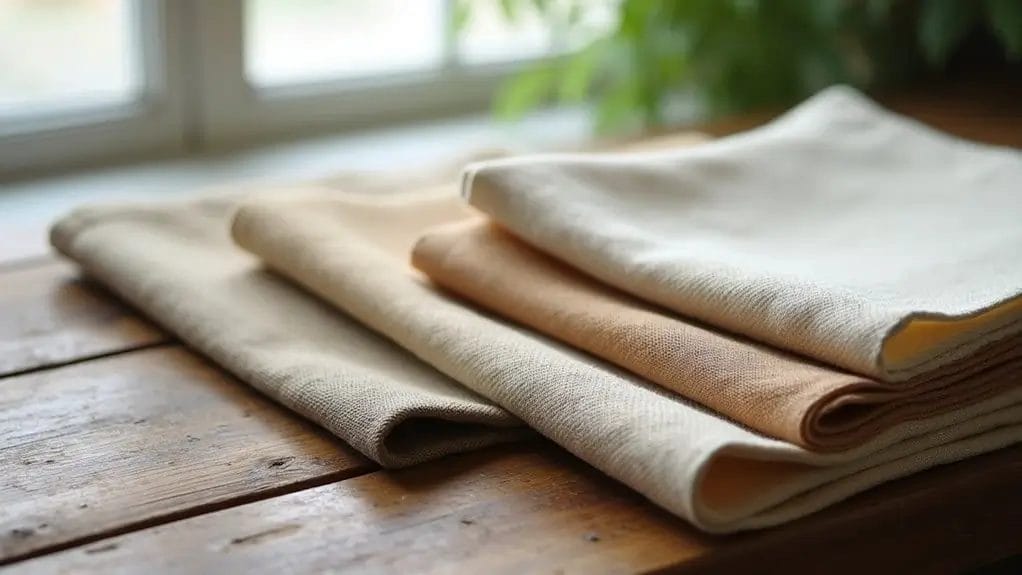
Selecting the ideal canvas for your project requires evaluating key technical specifications like fiber content, weight (measured in ounces per square yard), and weave density.
You'll need to match these specifications to your project's functional requirements, considering factors such as weatherproofing for outdoor applications, dimensional stability for stretched artwork, or durability for upholstery.
The texture and surface characteristics of your chosen canvas will directly impact both workability and final results, making it essential to assess properties like tooth for paint adhesion or smoothness for digital printing.
Key Factors to Consider When Choosing Canvas
Three essential factors guide the selection of appropriate canvas fabric: weight, weave density, and fiber composition.
When you select the right canvas for your project, consider these critical specifications:
- Weight determines durability - heavier cotton canvas (12oz-15oz) offers superior longevity for professional artist canvas and architectural applications.
- Weave density affects gesso absorption and surface texture - tighter weaves create smoother finishes on canvas panels.
- Fiber composition impacts strength - 100% cotton provides ideal flexibility and paint adhesion.
- Treatment requirements vary - raw canvas needs proper sizing and priming, while pre-primed options offer immediate use.
Matching Canvas Type to Project Needs
Once you understand the fundamental canvas specifications, matching specific canvas types to your project requirements becomes a practical next step.
Different types of canvas come in a wide variety of weights, weaves, and finishes to suit distinct applications.
Cotton duck canvas makes it ideal for detailed artwork and is the perfect canvas option for artists seeking controlled paint absorption.
Industrial-grade canvas offers superior strength for heavy-duty applications like tarps and covers.
Cotton-polyester blends provide versatile performance across multiple uses, combining durability with flexibility.
Consider the project's exposure to elements, required longevity, and specific performance characteristics when selecting your canvas material.
Assessing Weight and Texture for Specific Uses
The weight and texture of canvas directly impact its performance characteristics and workability for specific applications.
Cotton canvas is known for its strength and durability, making it a versatile fabric that'll affect the quality of your finished product.
- Lightweight canvas (4-8 oz) works best for tote bags, clothing, and light upholstery.
- Medium-weight canvas (8-12 oz) proves ideal for awnings, outdoor furniture, and medium-duty gear.
- Heavy-weight canvas (12-16 oz) suits marine applications and industrial equipment covers.
- Duck canvas (16+ oz) becomes stronger and more durable, perfect for heavy-duty commercial projects.
Choose your canvas weight based on your project's specific durability requirements and intended use.
Frequently Asked Questions
How Do I Properly Clean and Maintain Canvas Fabric?
You'll need to vacuum debris, spot-clean stains with mild detergent, scrub gently with a soft brush, rinse thoroughly, and air-dry completely. Avoid harsh chemicals and apply fabric protector annually for longevity.
Can Canvas Fabric Be Dyed or Painted After Purchasing?
You can dye or paint canvas using fabric dyes, acrylic paints, or textile mediums. Pre-treat the fabric with a fixative, apply your colorants in even coats, and heat-set the pigments for permanence.
What Is the Average Lifespan of Canvas Products?
You'll find properly maintained canvas products typically last 5-10 years. With UV-protective coatings and water-repellent treatments, heavy-duty canvas can extend to 15-20 years, depending on environmental exposure and usage patterns.
Is Canvas Fabric Naturally Waterproof?
Canvas isn't naturally waterproof, though it's water-resistant. You'll need to treat it with waterproofing agents like polyurethane, silicone, or wax coatings to achieve full water impermeability. The fiber's tight weave provides initial resistance.
Does Canvas Shrink After Washing, and by How Much?
You'll experience 1-3% shrinkage when washing untreated canvas, with natural fibers shrinking more than synthetics. Pre-shrinking's essential - hot water wash and high-heat dry will maximize initial fabric contraction.
Conclusion
Your canvas selection should prioritize weave density, fiber composition, and intended application parameters. When you're evaluating options, assess the thread count specification, tensile strength requirements, and surface texture characteristics. You'll need to match these technical aspects with your project's specific demands, whether it's for fine art production, industrial applications, or outdoor installations. Consider weight classification, dimensional stability, and weathering resistance in your final specification process.

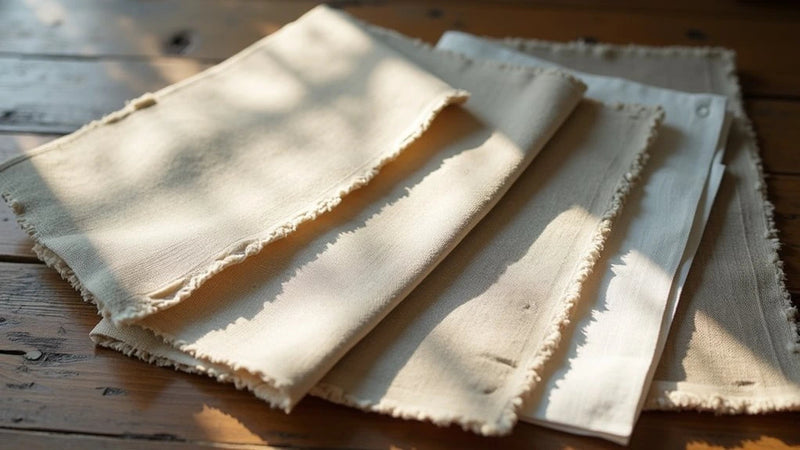
0 comments